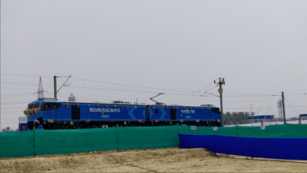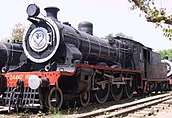Indian locomotive class WAG-12
| WAG-12[1] | |||||||||||||||||||
|---|---|---|---|---|---|---|---|---|---|---|---|---|---|---|---|---|---|---|---|
 WAG 12 during inauguration in Madhepura in Bihar | |||||||||||||||||||
| |||||||||||||||||||
| |||||||||||||||||||
| |||||||||||||||||||
| |||||||||||||||||||


The WAG-12 (Wide/broad Gauge AC Electric Goods/freight, Class 12) is a three phase, twin-section electric freight locomotive consisting of two identical sections, each of which rests on twin-axled bogies. The locomotive is being jointly developed by Alstom and Indian Railways, and is the first Indian Railways locomotive that has a power output greater than 10,000 horsepower. With a power output of 12,000 hp,[7] it is twice as powerful as its immediate predecessor, WAG-9, and is one of the most powerful freight locomotives in the world.[8] The locomotive is being developed for deployment on the Eastern Dedicated Freight Corridor, where it will be used to haul freight trains weighing more than 6,000 tonnes (5,900 long tons; 6,600 short tons) at speeds of 100 km/h (62 mph) to 120 km/h (75 mph), essentially doubling the average speed of freight trains in the sector.[5]
Development of the locomotive began after Indian Railways signed a record deal in November 2015 with Alstom for the development of 800 high-horsepower electric freight locomotives. The cost of production was estimated to be ₹19,904 crore (equivalent to ₹210 billion or US$3.0 billion in 2017).[9]
The first locomotive of the class was initially expected to enter service on 28 February 2018.[10] However, the locomotive was launched by Prime Minister Narendra Modi in Madhepura, Bihar on 10 April 2018.[11]
Development
The origins of WAG-12 can be traced back to a railway project approval in 2006, but no progress was made in the months that followed.[12] In June 2008, the Ministry of Railways invited bids from global firms to design and develop the locomotives. The initial deal was to set up a new electric locomotive factory at Madhepura, Bihar to build and maintain 660 high-horsepower locomotives in a joint venture where Indian Railways would hold a 26% stake and the bidder 74%. This would have been the first foreign direct investment in the fully state-owned railway sector of the country.[13] This invitation received bids from General Electric, Alstom, Bombardier, Siemens, China CNR, and CSR Corporation Limited. The number of locomotives to be built was also increased from 660 to 800.[12] The Research Design and Standards Organisation published a specification in June 2013,[14] detailing the capability requirements for an eight-axle locomotive intended to be used on Eastern Dedicated Freight Corridor (EDFC). It was not until November 2015, however, that Alstom was finally awarded the contract to build the locomotives.[15]
The eight-axle design of the locomotive reportedly improves performance and minimizes energy consumption and maintenance costs. The locomotive incorporates special features based on the Alstom Prima T8 for operations in humid or dusty environments and extreme temperatures ranging from −50 °C (−58 °F) to 50 °C (122 °F). The cabin of the locomotive is comparatively larger and offers better comfort for drivers, especially during long-distance operations. The locomotives can also be equipped with climate control systems such as air conditioners, food preparation and storage facilities, and even a toilet[4]—a standard that Indian Railways introduced in 2016.[16]
Production
As development of the engines progressed, Alstom outsourced the task of producing traction transformers for the locomotives to Swedish-Swiss multinational corporation ABB Group in 2016. As part of the Make in India initiative, these all-weather transformers were to be produced in Vadodara, Gujarat.[17] In 2017, Alstom outsourced the task of developing, testing, and maintaining the brakes of the locomotives to German brake manufacturing firm Knorr-Bremse. Also a part of the Make in India initiative, these brakes were to be produced at Palwal in the Indian state of Haryana.[18] The couplers of the locomotive were designed and developed by French Railway company Faiveley Transport. Around 85-90% of the components will be procured from within India.[8] The first body shell of the locomotive was delivered to the Haldia Port in West Bengal on 20 September 2017. It was then transferred to the Electric Locomotive Factory (Alstom Madhepura) for final assembly,[1] which began on 11 October 2017.[3][19] The first locomotive, numbered 60001, was tested in the Madhepura factory on 27 February 2018, one day before its initial launch date.[10][6]
Deliveries of the locomotives are planned from 2018 through 2028, with the first locomotive slated to enter service in 2018, and a total of five by 2019. This is to be followed by the assembly of 35 new locomotives in 2020, 60 in 2021, and 100 locomotives each year from 2022 until all 800 locomotives are delivered.[20]
| 2018 | 2019 | 2020 | 2021 | 2022 | 2023 | 2024 | 2025 | 2026 | 2027 | 2028 | Total |
|---|---|---|---|---|---|---|---|---|---|---|---|
| 1 | 4 | 35 | 60 | 100 | 100 | 100 | 100 | 100 | 100 | 100 | 800 |
See also
References
- 1 2 "Alstom delivers first locomotive bodyshell to India". Railway Gazette. Retrieved 2 January 2018.
- 1 2 "Alstom to supply 800 electric locos to Indian Railways". Railway Gazette. Retrieved 2 January 2018.
- 1 2 "Production starts at Indian electric locomotive factory". Railway Gazette. Retrieved 2 January 2018.
- 1 2 "Alstom Prima T8 Heavy Freight Locomotives Specifications" (PDF). Alstom. Retrieved 5 January 2018.
- 1 2 "Alstom to manufacture 800 high HP electric locomotives in Madhepura". Economic Times. Retrieved 2 January 2018.
- 1 2 "Alstom Prima locomotive for Indian Railways on test". Railway Gazette. 27 February 2018. Retrieved 2 March 2018.
- ↑ "India Gets Its First High Horse Power Locomotive From France". NDTV. Retrieved 2 January 2018.
- 1 2 3 "Local sourcing to be major focus of Alstom's Madhepura e-loco factory". The Hindu Business Line. Retrieved 2 January 2018.
- ↑ "Railways inks pact with GE, Alstom for loco factories". The Hindu. Retrieved 2 January 2018.
- 1 2 "First electric locomotive from Madhepura factory in Bihar to roll out on February 28". Hindustan Times. Retrieved 2 January 2018.
- ↑ Team, BS Web (2018-04-10). "Modi launches India's most powerful electric locomotive in Bihar: 10 facts". Business Standard India. Retrieved 2018-04-10.
- 1 2 "Six firms vie for Bihar locomotive project". Livemint. Retrieved 2 January 2018.
- ↑ P. R Sanjai. "Railways to buy 660 electric engines for €3.5 billion". Livemint. Retrieved 2 January 2018.
- ↑ "Specification RDSO/2006/EL/SPEC/0044, Rev '13'" (PDF). June 2013.
- ↑ "Alstom wins Indian electric locomotive contrac". International Railway Journal. Retrieved 2 January 2018.
- ↑ Sood, Jyotika. "After 163 years, Railways to put toilets in train engines". LiveMint. Retrieved 5 January 2018.
- ↑ "Prima India locos to have ABB transformers". Railway Gazette. Retrieved 2 January 2018.
- ↑ "Knorr-Bremse to supply brakes for Alstom's Indian locomotives". Railway Gazette. Retrieved 2 January 2018.
- ↑ "Indian Railways WAG 12". Financial Express.
- ↑ "Faster, Fitter & French: 7 Things to Know About India's New High-Power Locomotives". The Better India. Retrieved 2 January 2018.


_Sathavahana_Express_at_Ghatkesar.jpg)
